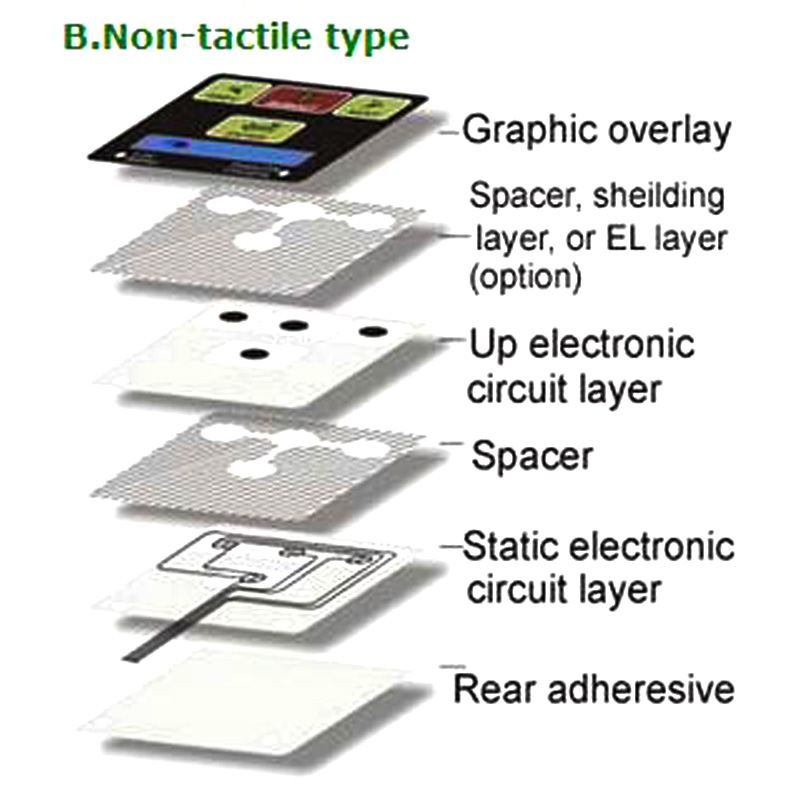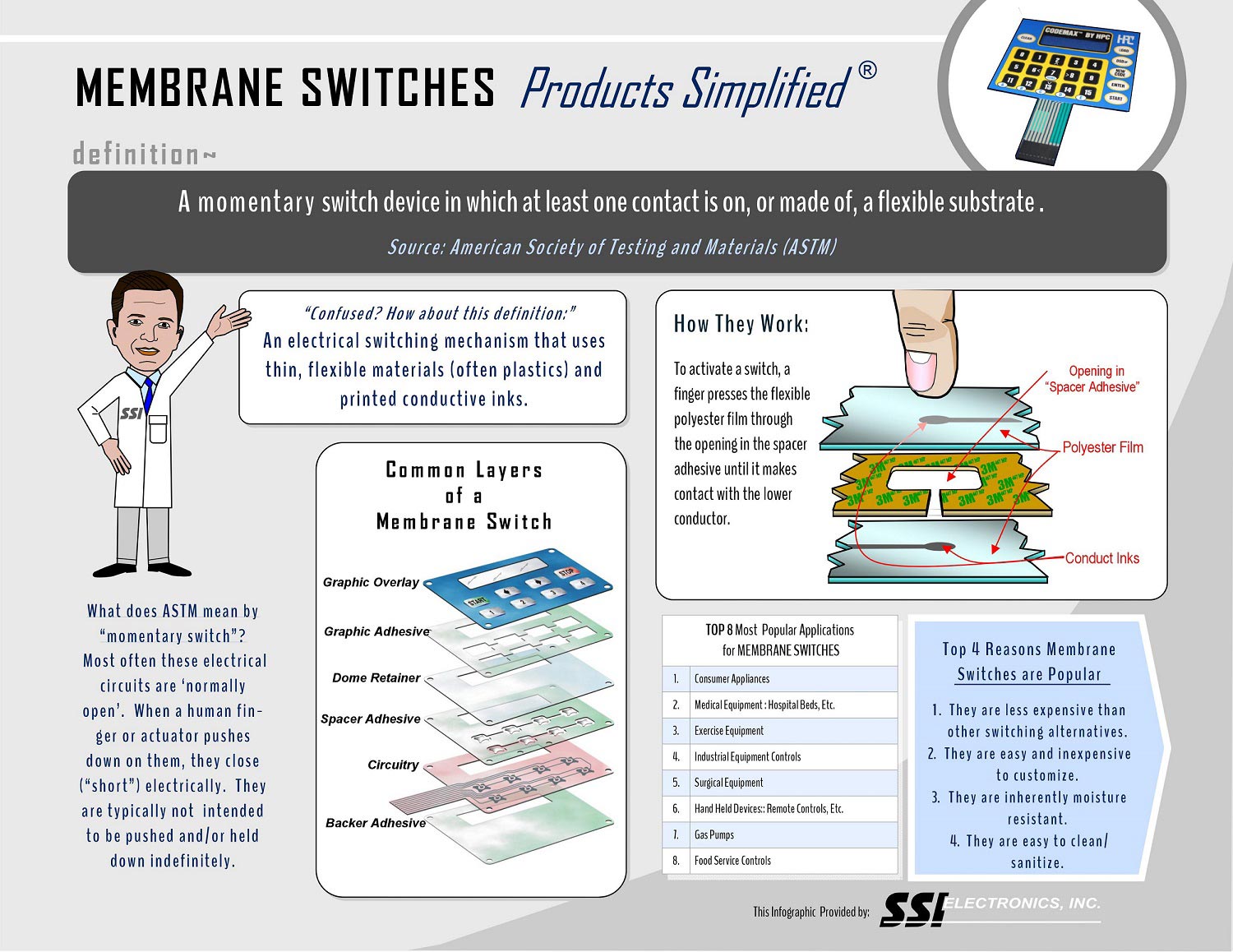Understanding the Significance of Membrane Change in Modern Electronics
Membrane buttons are important parts in contemporary electronic gadgets. They use a blend of functionality and layout that enhances user communication. Their resilient and light-weight nature makes them ideal for numerous applications. As sectors progress, the demand for customization and advanced features expands. Comprehending how membrane layer changes add to technology reveals their significance fit the future of electronics. What exists ahead for this innovation?
The Fundamentals of Membrane Layer Change Innovation
Typically neglected, membrane layer button modern technology plays a vital duty in the contemporary electronic devices landscape. These devices, composed of multiple layers, function as interface for different digital products, ranging from house appliances to clinical equipment. A normal membrane layer switch includes a visuals overlay, a spacer layer, and a circuit layer, which are carefully assembled to develop a practical interface.When stress is related to the overlay, the circuit layer is completed, permitting signals to be sent to the gadget. This modern technology is known for its flexibility, enabling modification in form, style, and performance to meet particular customer needs. Furthermore, membrane switches are thin and lightweight, making them appropriate for applications where space is a premium. Their toughness and resistance to environmental aspects better boost their allure, ensuring they can stand up to extreme problems while preserving capability. On the whole, membrane layer button modern technology is essential to producing effective and straightforward electronic devices

Key Benefits of Membrane Switches Over
Membrane layer changes deal a number of vital benefits that make them a favored choice in numerous digital applications. Their layout permits a compact type factor, making it possible for suppliers to develop streamlined and lightweight gadgets. Furthermore, membrane layer switches are immune to dust, moisture, and chemicals, which enhances their resilience and durability popular atmospheres. The tactile comments given by these buttons can enhance customer experience, making them simple and instinctive to operate.Furthermore, membrane switches can be customized with varied graphics and shades, enabling for distinct branding possibilities. The manufacturing procedure is generally cost-effective, particularly for high-volume manufacturing, as it decreases assembly time and streamlines layout. Membrane switches over require very little maintenance, adding to reduced overall operational prices. These advantages emphasize their expanding appeal in contemporary electronic devices, where reliability and easy to use user interfaces are important.

Applications Throughout Different Industries
The versatility of membrane switches over allows their prevalent adoption across different sectors. In the clinical field, they are generally made use of in analysis devices and client monitoring systems, using a long lasting user interface resistant to impurities. The auto sector makes use of membrane layer buttons for dashboard controls, boosting user experience with sleek layouts that hold up against rough problems. In consumer electronics, they function as control panels for devices such as microwaves and coffee machine, providing a straightforward interface that is very easy to clean. The aerospace industry uses membrane layer buttons in cabin controls, where reliability and space performance are vital. Additionally, the industrial field leverages these buttons in machinery and control systems to ensure webpage robust procedure sought after settings. This broad range of applications emphasizes the versatility of membrane buttons, making them essential parts in enhancing capability and customer communication across varied technical landscapes.
Modification and Layout Versatility

Future Fads in Membrane Switch Development
Emerging trends in membrane button development suggest an expanding emphasis on improved performance and combination with clever modern technologies. As customer need for a lot more innovative electronic devices increases, manufacturers are concentrating on developing membrane layer changes that not only offer standard operational roles but additionally integrate attributes like touch level of sensitivity, backlighting, and haptic feedback.Furthermore, innovations in materials are expected to boost durability and ecological resistance, making membrane layer switches over appropriate for diverse applications in sectors such as health care, vehicle, and consumer electronics. The assimilation of capacitive touch innovation is likely to come to be a lot more prevalent, allowing for sleeker styles and enhanced user interfaces. membrane switch.Additionally, the increase of the Internet of Points (IoT) is motivating the growth of membrane layer changes that can communicate wirelessly with various other gadgets, boosting interconnectivity. Generally, the future of membrane button innovation shows up appealing, driven by technology and the quest of easy to use remedies
Often Asked Inquiries
Exactly How Do Membrane Changes Contrast to Conventional Mechanical Buttons?
Membrane buttons, being much more space-efficient and providing a smooth design, comparison with standard mechanical buttons that provide tactile feedback. The previous commonly feature adjustable graphics, while the last typically assure resilience and integrity in various applications.
What Materials Are Commonly Made Use Of in Membrane Change Manufacturing?
Membrane buttons are typically created utilizing materials such as polyester, polycarbonate, and printed conductive inks. These products give sturdiness, responsiveness, and flexibility, making them ideal for different applications in electronic gadgets and individual interfaces.
Can Membrane Switches Be Repaired or Reused?
Membrane switches can frequently be repaired, specifically if small issues emerge, such as adhesive failure or surface area damage. Full reuse is usually limited due to put on and possible degradation of materials over time.
Exactly How Do Ecological Aspects Affect Membrane Layer Switch Performance?
Ecological aspects, such as temperature level, exposure, and moisture go to chemicals, greatly affect membrane button efficiency. Extreme conditions can bring about degradation, affecting responsiveness and long life, eventually endangering the functionality of the tool in different applications.
What Is the Regular Lifespan of a Membrane Layer Switch over?
The common life-span of a membrane switch typically ranges from 1 to 5 million actuations, depending upon variables such as usage frequency, environmental problems, and the products made use of in manufacturing, affecting resilience and efficiency longevity. A typical membrane switch is composed of a graphic overlay, a spacer layer, and a circuit layer, which are diligently constructed to produce a practical about his interface - membrane switch.When stress is used to the overlay, the circuit layer is finished, allowing signals to be transmitted to the gadget. The responsive comments supplied by these buttons can enhance individual experience, making them instinctive and very easy to operate.Furthermore, membrane switches can be customized with varied graphics and shades, allowing for unique branding opportunities. As consumer need for a lot more innovative digital tools boosts, producers are focusing on producing membrane layer changes that not only serve fundamental operational roles however additionally include attributes like touch level of sensitivity, backlighting, and haptic feedback.Furthermore, innovations in materials are expected to boost durability and environmental resistance, making membrane switches suitable for varied applications in sectors such as medical care, automotive, and customer electronic devices. The combination of capacitive touch innovation is most likely to come to be a lot more common, allowing for sleeker styles and enhanced user interfaces.Additionally, the surge of the Net of Points (IoT) is motivating the advancement of membrane switches over that can interact wirelessly with other devices, boosting interconnectivity. Membrane layer switches, being extra space-efficient and offering a streamlined style, comparison with standard mechanical switches that offer responsive comments